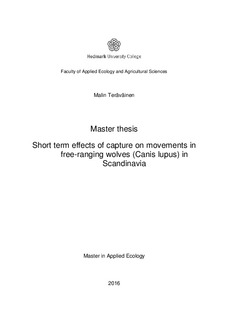Short term effects of capture on movements in free-ranging wolves (Canis lupus) in Scandinavia
Master thesis
Permanent lenke
http://hdl.handle.net/11250/2392483Utgivelsesdato
2016Metadata
Vis full innførselSamlinger
Sammendrag
Remote monitoring of wild animals by radio-tags and bio-sensors is frequently applied in
wildlife research, monitoring and management. These methods require capture and often anaesthesia
of animals that in turn may affect post-capture behaviour. Assessment of post-capture
effects is needed to avoid biases in the research data due to capture-related effect on behaviour,
but also to measure unnecessary discomfort and suffering for the animals.
The Scandinavian wolf population has since its reappearance in the 1980´s been the subject to
many studies, and the first wolves were radio collared in 1999. Between 1998 and 2015 several
wolves have been captured in Scandinavia. For this study I used hourly GPS positions during
the first 100 hours from 25 wolves chemically immobilized between 2001 and 2015. I examined
how the cumulative post-capture movement was related to the intrinsic variables sex,
body mass and social status, and to capture-related variables, number of captures, pursuit time
and the type and dose of drugs used.
Sex was the most important factor explaining patterns of post-capture movement. Males had
a higher movement rate than females between the release and 23 hours post capture. Body
mass was correlated with sex and was positively related to sex-specific movement rates. Contrary
to my initial predictions, medetomidine given as an additional tranquilizer during handling
increased the movement rate after capture. I also found weak relationships between
movement rate and the time the wolf was chased by helicopter prior the immobilisation, and
between movement rate and drug doses. The small sample size however limits the inferences
that can be drawn from these models.
I conclude that capture-related factors can induce differences in post-capture movements of
wolves, and that sex is an important predictor of post-capture movement patterns.
Beskrivelse
Master i anvendt økologi. Evenstad 2016
